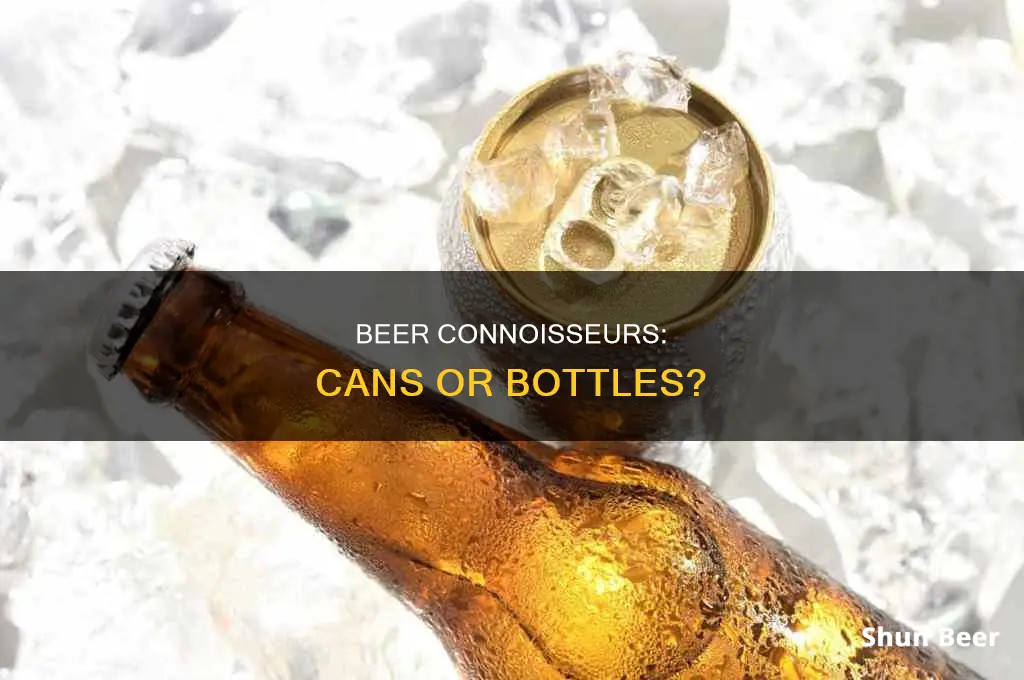
There are several factors to consider when deciding whether to drink beer from a can or not. Firstly, cans offer perfect opacity, protecting the hops from light, which can cause a skunky aroma and taste. Cans are also easier to store and transport due to their lightweight and stackable design, resulting in lower emissions during transportation and distribution. Additionally, cans are more suitable for outdoor settings as they are unbreakable and allowed in public places that often restrict glass bottles for safety reasons. Furthermore, cans have a larger surface area for branding and communication with consumers.
However, there are also some drawbacks to consider. There is a stigma associated with beer cans, as they are often associated with cheap, low-quality beer. Additionally, aluminium, the primary material used in cans, has been linked to potential health risks by organisations like the ASEF (Association de la santé et de l'environnement en France). The production of aluminium is also harmful to the environment and energy-intensive. Another concern is the presence of a plastic film lining the inside of the can, which may contain BPA (bisphenol A), a known endocrine disruptor. Finally, beverage cans can harbour microbes, which may contaminate the beer even when poured into a glass.
What You'll Learn
- Cans block light, preventing a skunky aroma and taste
- Cans are lighter, reducing emissions and improving ease of transport
- Aluminium is toxic to health and dangerous for workers
- Glass bottles are better for the environment if they are reused
- Beer tastes better from a bottle, but only if you can see the packaging

Cans block light, preventing a skunky aroma and taste
One of the most significant advantages of drinking beer from a can is that cans block 100% of light, preventing a skunky aroma and taste. A photochemical reaction occurs when sunlight or fluorescent lighting strikes beer. This light breaks down hop alpha acids, which then react with sulfur compounds in the beer, resulting in an unpleasant skunky aroma and taste.
Although brown bottles block some light, they do not provide complete protection, and over time, the beer is still affected. On the other hand, cans offer full protection from light, ensuring that the beer remains as the brewer intended it to be tasted. This is especially important for beer enthusiasts who want to experience the full flavor and aroma of their beverage without any unwanted light-induced alterations.
The ability of cans to block light is a significant advantage over glass bottles, which are susceptible to light penetration. This feature of cans not only preserves the intended flavor and aroma of the beer but also helps prevent skunked beer, enhancing the overall drinking experience.
In addition to blocking light, cans also have other benefits, such as ease of transportation due to their lightweight and stackable nature. They are also more environmentally friendly, with a lower carbon footprint during transportation and distribution due to their lighter weight compared to bottles. Furthermore, cans are more widely accepted in public places and outdoors because they are unbreakable and safer than glass bottles.
Beer and Pradaxa: Is It Safe to Drink Alcohol?
You may want to see also

Cans are lighter, reducing emissions and improving ease of transport
Cans are much lighter than bottles, weighing only 15 grams compared to a bottle's 170 grams. This weight difference has several significant advantages, including reduced emissions and improved ease of transport.
Firstly, the lower weight of cans means reduced emissions and a smaller carbon footprint during transportation and distribution. The reduced weight leads to lower fuel consumption and fewer carbon emissions for the same volume of beer. This contributes to a more sustainable and environmentally friendly beer industry.
Secondly, the lighter weight of cans improves ease of transport, benefiting both distributors and consumers. Distributors can fit more cans into their trucks, optimising logistics and reducing the number of trips required. For consumers, especially those enjoying outdoor activities like picnics or hiking, the lighter weight of cans makes a noticeable difference. Carrying a six-pack of cans instead of bottles reduces the load and enhances portability, making it more convenient for consumers to enjoy their favourite beverage wherever they go.
The weight advantage of cans becomes even more pronounced when considering bulk purchases or larger quantities. Whether stocking up for a party or simply buying in bulk for everyday consumption, opting for cans instead of bottles can significantly reduce the weight one has to carry or transport. This weight reduction is beneficial for both the consumer doing the shopping and the retailer stocking the shelves.
In addition to the weight advantage, cans also offer other benefits, such as blocking 100% of light, preventing oxygen ingress, and being more durable and stackable. These advantages contribute to the overall ease of transport and make cans a more attractive option for consumers seeking convenience and portability without compromising on taste or quality.
Beer Drinking: Immune System's Worst Enemy?
You may want to see also

Aluminium is toxic to health and dangerous for workers
Aluminium is used in the production of cooking utensils, foils, printing ink, glass, ceramics, pottery, incandescent filaments, fireworks, explosives, photographic flashlight, electric insulators, cement, paints and varnishes, fumigants and pesticides, lubricants, detergents, cosmetics, pharmaceuticals (drugs), vaccines, as well as in water treatment and purification, treating sewage and fur, tanning leather, waterproofing clothes and concretes, industrial filtration, hemodialysis, measuring radiation exposure, in products as flame retardant and fireproofing, anticorrosion agent, food additives to prevent caking as well as components of baking powders and colorants.
Aluminium is also used in the production of antiperspirants and cosmetics. Aluminium chlorohydrate (ACH) is an active component of antiperspirants and deodorants. Their mechanism of action is deposition in the eccrine sweat glands and producing insoluble aluminium hydroxide. This causes loosening of sweat plaques and blocking sweat secretion.
Aluminium is also used in the production of vaccines. Almost 75% of all adjuvant-based treatments include aluminium salts. The amount of aluminium salts in the vaccine depends on the manufacturer; for example, low-dose diphtheria/tetanus vaccine contains 170 micrograms per dose, or high-dose haemophilus influenza type b vaccine contains 850 micrograms of the salts in each dose.
Aluminium is also used in the production of dialysis solution and total parenteral nutrition solutions.
Aluminium is a prooxidant and may lead to biological oxidation both in vitro and in vivo. Protein polypeptides are transformed to secondary structures when Al ions interact with them through oxygen-containing amino acids, side chains and protein backbone leading to ultimate denaturation or conformational or structural alteration as in β-amyloid. The aggregation and precipitation of β-amyloid is triggered and potentiated by Al exposure which is associated with Alzheimer’s disease and this phenomenon may be responsible for neuritic plaque deposition, neuronal death and dysneurogenesis.
Aluminium is also used in the production of antacids. Antacid and sucralfate-induced hypophosphatemic osteomalacia: A case report and review of the literature. Chronic exposure of mice (5 months) to Al sulfate in drinking water elicited time-dependent systemic inflammation characterized by increased serum interleukin-6 (IL-6) and tumor necrosis factor alpha (TNFα), C-reactive protein (CRP) and a triad of pro-inflammatory microRNAs (miRNA-9, miRNA-125b and miRNA-146a) and the biomarkers of inflammation indicated progressive chronic inflammation in the exposed animals.
Aluminium is also used in the production of phosphate binders. Phosphate binders, antacids, buffered analgesics, antidiarrheal and antiulcer drugs.
Beer Consumption: What's Safe to Drink?
You may want to see also

Glass bottles are better for the environment if they are reused
Glass bottles are a more environmentally friendly option than cans if they are reused. While producing glass requires a tenth of the energy of virgin aluminium, it is twice as energy-intensive as manufacturing recycled aluminium. However, the overall energy balance of a can is better than a single-use glass bottle due to the lower energy requirements of recycling aluminium.
Recycling a can uses 90% less energy than recycling a glass bottle. Nevertheless, if glass bottles are reused multiple times, they become a more sustainable option. The process of recycling glass is very energy-intensive, but as energy sources become more renewable, this will no longer be a significant issue.
Glass bottles also have the advantage of being non-porous and impermeable, preventing any interactions between the glass packaging and the products inside. This results in no nasty aftertaste and preserves the flavour, strength, and aroma of the contents. Additionally, glass does not leech chemicals into the environment as it breaks down, unlike plastic.
However, it is important to note that glass is heavier than plastic and cans, resulting in higher transportation costs and fuel usage. Glass is also more fragile, which can increase the likelihood of breakage during transit. Despite these drawbacks, glass bottles that are reused multiple times remain an eco-friendly solution.
Old Beer: Drink or Dump?
You may want to see also

Beer tastes better from a bottle, but only if you can see the packaging
There are a number of factors to consider when it comes to the age-old debate of whether beer tastes better from a bottle or a can. While some people prefer the taste of bottled beer, others argue that there is no difference as long as the beer is poured into a glass.
One of the main advantages of drinking beer from a can is that cans block 100% of light, preventing a skunky aroma and taste that can occur when sunlight or fluorescent lighting strikes the beer. In comparison, brown bottles only block some of the light, and green and clear glass bottles block almost none of the damaging light. Additionally, cans are easier to transport due to their lighter weight, and they are more outdoor-friendly since they are unbreakable and allowed in public places like beaches, parks, and camping sites that do not permit glass bottles.
On the other hand, some people associate cans with cheap, low-quality beer. The stigma of cans may be due to the common experience of finding them littered and the fact that they don't feel as sophisticated as bottles. The taste of beer from a can may also be affected by the aluminium or plastic lining, which can give off a metallic flavour.
A study published in the journal Beverages set out to answer the question of whether beer tastes better from a bottle or a can once and for all. The study consisted of three parts: a questionnaire, a taste test, and a blind taste test. The results of the initial questionnaire suggested that people have preconceived preferences for beer packaging types, with 61.29% of participants preferring beer from a bottle, 11.29% preferring beer from a can, and 27.42% thinking that it made no difference.
During the main taste test, participants were shown the bottle or can and were allowed to examine it before the beer was poured into a plastic cup and served to them. The results showed that participants rated the beer poured from the bottle as tasting significantly better than the beer poured from the can. Perceived quality was also rated slightly higher for the bottled beer.
However, when a blind taste test was conducted, where participants were not allowed to see the researchers pour the beers into the glasses and had no knowledge of the beers or their packaging, the preference for bottled beer over canned beer disappeared. Nearly 45% of participants rated the canned beer better, 41% preferred the bottled beer, and 1.5% said they tasted the same.
So, what does this all mean? The results of the study suggest that when it comes to beer, your preference for bottled or canned beer may be all in your head. If you can see the packaging, you might assume that beer from a bottle will taste better, but if you take away any knowledge of the beer and its original packaging, the preference for bottled beer seems to disappear. Therefore, it can be concluded that beer tastes better from a bottle, but only if you can see the packaging.
Beer's Metallic Taste: Safe or Unsafe to Drink?
You may want to see also
Frequently asked questions
Aluminium is toxic to health and is used in the production of cans. The ASEF (Association de la santé et de l'environnement en France) warns that aluminium in food packaging can migrate to food when heated and if the food is acidic. The EFSA (European Food Safety Authority) has set a maximum weekly dose of 1 mg/kg, which would be exceeded by a significant part of the population.
The plastic film inside the can is an endocrine disruptor. According to INERIS (the National Institute for Industrial Environment and Risks, France), the transparent film lining the inside of beverage cans is made of BPA (bisphenol A), a synthetic hormone that has been highly controversial.
Yes, cans block 100% of light, preventing a skunky aroma and taste. They are also lighter, easier to store and transport, and are allowed in many public places where glass bottles are not.







